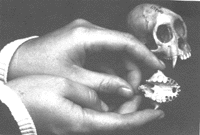 Although the fossil record (notably from caves of
the Cockpit Country) demonstrates a more diverse mammalian
community in the past, including one endemic primate (Xenothrix
mcgregori) and at least two species of caviomorph rodents
(Family: Heptaxodontidae, Clidomys osborni and C.
parvus) from the later Quaternary and one rhinocerotoid
ungulate (Hyrachyus sp.) from the late early or middle
Eocene [the oldest specimen of West Indian land mammal found and
demonstration that at least one land mammal of Holarctic affinities
lived in Jamaica prior to the island's middle-Eocene-late Miocene
submergence) (MacPhee 1984, Domming et al. 1997)], the sole
extant native rodent is the Jamaican hutia (coney) (Geocapromys
brownii). Their habit of nesting among limestone boulders makes
cave entrances attractive to hutias and their bones are common in
cave breccia in the Cockpit Country (Anthony 1918-19, MacPhee 1984,
Pregill et al.1991). Where hutias continue to survive on
Jamaica, the majority of their populations are subjected to
intensive hunting pressures (Oliver 1982).
Although the fossil record (notably from caves of
the Cockpit Country) demonstrates a more diverse mammalian
community in the past, including one endemic primate (Xenothrix
mcgregori) and at least two species of caviomorph rodents
(Family: Heptaxodontidae, Clidomys osborni and C.
parvus) from the later Quaternary and one rhinocerotoid
ungulate (Hyrachyus sp.) from the late early or middle
Eocene [the oldest specimen of West Indian land mammal found and
demonstration that at least one land mammal of Holarctic affinities
lived in Jamaica prior to the island's middle-Eocene-late Miocene
submergence) (MacPhee 1984, Domming et al. 1997)], the sole
extant native rodent is the Jamaican hutia (coney) (Geocapromys
brownii). Their habit of nesting among limestone boulders makes
cave entrances attractive to hutias and their bones are common in
cave breccia in the Cockpit Country (Anthony 1918-19, MacPhee 1984,
Pregill et al.1991). Where hutias continue to survive on
Jamaica, the majority of their populations are subjected to
intensive hunting pressures (Oliver 1982).
The present status of hutias in the Cockpit Country environs is unknown. Oliver (1982) noted that most local hunters and foresters interviewed were adamant that the species no longer occurs in the area or if they do occur, they are either sparsely distributed or at very low density. The only confirmation of their existence in the past 20 years is from the collection of fresh feces (scat) in a coco (Xanthosoma sagittifolium) plantation near Quickstep (Oliver 1982). First-hand reports of occasional captures or chance sightings date back to the 1950s and most of these reports are restricted to Aberdeen, Accompong and Maroon Town.
We value your feedback and comments: